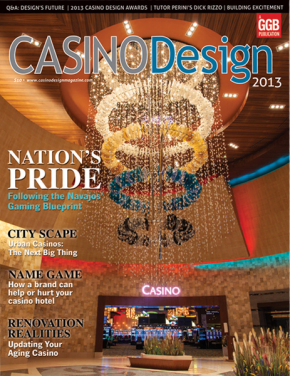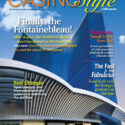
The reservation of the Navajo Nation is the largest in the United States, stretching across more than 27,000 square miles in Arizona, New Mexico and Utah. And with 250,000 citizens, it also has one of the largest native populations of any Indian tribe in the U.S.
But like all American tribes, the Navajos are still struggling more than 100 years after decades of war against the U.S. government have come to an end. Poverty, homelessness and illness have been a constant companion to the nation. But the culture, family and religion of the Navajos have sustained them for all this time, which was one of the reasons the nation didn’t race to join the gaming industry when it was introduced in Arizona and New Mexico during the early 1990s.
Twice, in 1994 and ’97, Navajo voters rejected an amendment that would have legalized gaming, fearing crime, alcoholism and other ills would increase on the reservation. But in 2004, a third vote was the charm and gaming was approved on the nation’s lands.
It was just in the nick of time, because the closing of the Black Mesa Coal Mine and a tribal ban on uranium mining in 2005 resulted in higher unemployment among the nation’s citizens and a steep drop in tribal revenues.
Then-President Joe Shirley began to advocate for the quick introduction of casino gaming, but tribal members were still concerned about the business risks that came along with the industry.
LoRenzo Bates, a Navajo councilman and chairman of the tribal budget committee, explains why the tribe was a bit reticent to jump into gaming without understanding the consequences.
“We were concerned about the amount of money it would take to get into it and where the money would come from,” he says. “We wanted to know how many jobs it would create and the other opportunities that are associated with gaming in terms of the nation’s revenue distribution.”
Negotiations were held with a management company, as well with banks that might fund the projects, but Bates says the council was still not satisfied.
“All of those issues were taken into consideration, and council established guidelines that must be present if we were going to get into gaming,” he says. “It narrowed down the ways we would finance it. Because we were the new kid on the block and because it would be a greenfield project, there was an anticipation that an outside source or funding agent would be charging a lot of interest. Up until that time, it was all on paper. It was completely projections.”
Derrick Watchman is now CEO of the Navajo Gaming Enterprise. A former banker, Watchman was mentored by Robert Winter, an experienced gaming executive the tribe brought in to run the nation’s gaming business, and Watchman took over as CEO earlier this year. He says there were two big mandates in the beginning.
“We were supposed to create revenue for the nation and jobs for the Navajo citizens,” he says. “And that continues to be our goal. I’m pleased with our progress, even though we’ve had to deal with the economic downturn and the other financial issues that still persist today. We’ve been more than holding our own.”
For the Navajo Nation, the decision to self-fund was an important one.
“The nation decided to make an investment in gaming, rather than taking the money from Wall Street,” says Bates. “We decided to use our own money as an investment to accomplish the goals and opportunities associated with gaming. That money would come back to the Navajo Nation rather than going to some bank or investors.”
The money comes back with interest—14 percent—which is higher than they may have gotten on Wall Street.
“But it all comes back to the nation,” says Bates.
In addition to keeping money on the reservation, there were other important issues to consider if you borrow money from banks.
“We sat down with our economic advisers and came up with a financing plan that worked for both sides, our gaming enterprise and the Navajo Nation,” says Bates. “That was a decision that needed to be made. Do we allow our gaming enterprise to borrow the money at a rate that would be satisfactory, and then you add the pieces of the puzzle, like collateral that these institutions require? But the most important thing to the Navajo Nation was what would happen in the event of a dispute. Where are we going to go? State court? Federal court? The prevailing position at the time was state court, and that was not going to be acceptable to the Navajo Nation.”
In addition to funding the projects themselves, the Navajo in 2006 decided against hiring a management company to run the gaming business. Navajo leaders hired Winter, an experienced Indian gaming executive, to get the operation off the ground, but more importantly, to mentor and teach Navajo how to do the jobs necessary to run it themselves.
Watchman says it was a smart move.
“The nation did an RFP and had a lot of offers to manage the business,” he says. “Eventually, they questioned why we needed to pay 30 percent of the profits to an outside company, when you can hire a team, led by Bob Winter, that was cheaper and more effective. I’m glad they took that position.”
Winter, who helped the legendary Mickey Brown build, operate and grow Foxwoods in Connecticut, understands that tribal gaming works best when the tribe is running it.
“His goal was to mentor Navajo members,” says Watchman, who took over for Winter in January. “He loves the nation and wanted to make gaming work for us.”
Bates says Winter has been very effective in allowing the nation to reach its revenue and employment goals.
“We didn’t want to forfeit any of the revenue or any of the control to an outside entity,” says Bates. “Bob Winter had decades of experience, and with the people that he was mentoring, the nation was comfortable with allowing him to run the enterprise.”
Site Selection
From the start, the primary discussion in Navajo council meetings was where the casinos would be located.
Consideration was given to taking land into trust in a more populated area, but Bates says that was rejected because of the length of time it would take to get all approvals.
“So we chose a site for the first casino on nation land adjacent to Interstate 40,” he says. “There weren’t any other casinos very close to there, so we believed it would be a success.”
The tribe’s first casino, Fire Rock, located in the nation’s Church Rock chapter in New Mexico, just east of Gallup, proved to be just that. It became popular with locals and with travelers along the highway, pumping money back into tribal coffers and giving the council confidence that other casinos could be built.
Watchman says a lot of research was done before sites were selected.
“When you look at the studies and the information that was put together, the ideal locations were near the borders of the reservation, where larger towns were located.”
The Navajo Nation is divided into 110 individual chapters, similar to counties in a U.S. state. Competition to host a casino in each chapter was fierce, and Bates says the council used the same criteria that it used in the Fire Rock decision—that any new casino would bring as much revenue to the nation as possible.
“We really just did the math,” says Bates. “Even though the area for our second casino was more remote, it was still 20 minutes from the nearest competition.”
The second casino is a Class II facility, Flowing Water Navajo Casino in the Tse Daak aan Chapter of Navajo Nation, near Shiprock, New Mexico. It was clearly a smaller facility, as befits the market. The third casino, Northern Edge, is located near Farmington, New Mexico, with an 80,000-square-foot casino offering 750 slots and a dozen table games.
Fire Rock was designed by JCJ Architects of Phoenix, in a joint venture with Navajo-owned Dyron Murphy Architects of Albequerque. Dyron Murphy was the sole designer of Flowing Water, the second Navajo casino. The third and fourth casinos, Northern Edge and Twin Arrows, were designed by Friedmutter Group of Las Vegas.
The Navajo knew there was going to be a major casino on the western side of the reservation from the start.
“We did a lot of economic and market analysis before we built anything,” explains Watchman. “In those studies, the Flagstaff area was deemed the ideal location for a casino hotel with all the amenities. The economic modeling suggested a hospitality enterprise would work best. And since the reservation ends 20 miles east of Flagstaff, a destination resort at that location was the best approach. We have 1,100 slot machines and 90 rooms at the current time, with 118 more planned, as well as meeting and convention space and restaurants. We have the related amenities that are important to a resort, as well. Since there are a very limited about of hotel rooms in that area, we believe we can tap into the tourist market for visitors to Arizona and Navajo country.”
A spa will open next year, and a golf course is planned for one of the future phases of Twin Arrows.
Design Excellence
While all four Navajo casinos contain references to the nation’s culture and history in their architecture, the last two truly reflect a maturing of that idea.
“In each location, the architecture reflects the Navajo culture as it applies to that area,” says Bates.
The Friedmutter Group has vast experience in Indian Country, but for the Navajos, special attention had to be paid to the traditions and culture.
“From the very beginning, the Navajo wanted cultural elements built into the project,” says Albie Colotto, director of design for Freidmutter. “They wanted to weave their story and their path through the architecture and have it come out in small story lines. They wanted to be able to explain their story to visitors, especially tribal members.”
Suzanne Couture, senior interior designer at Friedmutter, was responsible for the interiors at both Northern Edge and Twin Arrows.
“We went and spent time with tribal elders and people who were helping to educate us on tribal culture and traditions,” she says. “They wanted to assign different parts of their story to each property.
“At the Northern Edge property, they wanted to tell the story of the ‘Hero Twins,’ with references back to that story in their mythology. At Twin Arrows, they wanted to focus on the ‘Four Worlds,’ which is their creation story and how the Navajo came to be.”
At Northern Edge, a large mural represents a Navajo constellation, and the entry floor features a “dry painting” that uses several natural materials including white shell, representative of “White Shell Woman,” a Navajo legend.
The casino ceiling at Northern Edge is a representation of the Navajo tradition of weaving, and of “Spider Woman,” who taught Navajos how to weave. Custom chandeliers were created to incorporate the Navajo beliefs of the four sacred mountains, four sacred directions, and four sacred stones.
That theme is carried through in Twin Arrows, the tribe’s first casino resort, with dramatic re-telling of the nation’s mythology via the architecture and design.
“The ‘four worlds’ myth is a very vertically oriented story where people move through the four different worlds,” says Couture. “We used this description to build a chandelier in the reception area, with four different color circles to represent the four worlds, each represented by a different color.
“We also used elements of the wind, which is a strong element in Navajo culture, on the exterior of the property, and in chandeliers, carpet patterns and ceiling elements. Different spaces have different offshoots of these main stories.”
In the center of the casino is a high-limit video poker pit that contains exclusively WMS machines.
“The center of the casino,” says Couture, “is like a portal into the fifth world. While we’ve been through four worlds and live in the world now, we’re always moving toward another world. The metallic drapes, with color changes and lighting, symbolizes growing reeds that grow up toward future worlds. The colors symbolize a rainbow, which is how people travel through the Navajo worlds; it’s how you get to the next world.”
The outside of the building is a sweeping pattern that represents the wind and blends in with the surrounding dramatic high-desert landscape.
“The hotel tower is just a large-scale weave pattern,” says Colotto. “Weaving is very important in their culture, and it’s one of their high arts in which they express themselves.”
“We wanted the landscape and the building to be seamless.”
Navajo art extends through the hotel rooms, where the story is more about native craftsmanship than mythology, and the hotel is spilling over with Navajo art. “There’s artwork throughout the hotel that was designed by Navajo artists specifically for spaces we designed to showcase this art,” says Couture.
Watchman says the nation is considering installing a Navajo museum at the property.
“At Twin Arrows, we wanted to offer more of a Navajo cultural experience,” he explains. “Being so close to I-40, there is really no Navajo experience there. We have a very nice museum up at (Navajo capital) Window Rock, but nothing that captures the I-40 traffic.”
Even the positioning of the buildings reflects Navajo beliefs.
“All the buildings face east, bring light and life into the building, another part of the Navajo culture,” says Couture. “On the west side is the convention center. The west is the direction of family gatherings and celebrations, so we tried to incorporate Navajo culture and tradition into every element of the buildings.”
Colotto says working with the tribe went very smoothly, with an assist from technology.
“We use a computer program that allows us to faithfully reproduce what we are planning to design, so there were no surprises on either side,” he explains. “They knew and could visualize exactly what we were planning to build. In fact, many of them have commented about how much the final product was almost exactly what we had showed them.”
JBA Consulting Engineers was the engineering group chosen by the tribe to be responsible for the mechanical, plumbing and electrical design of the project. J.J. Wisdom, the senior project manager, says JBA was very sensitive to the tribe’s vision for the property.
“Our involvement started at the onset of the project, assisting the architect with space planning to include required MPE spaces, continued with the design and coordination of MPE systems to produce construction documents and completed with construction administration that included monthly site visits during the construction of the project,” he says.
Wilson says exterior visual of the property was very important to the tribe.
“We worked with the architect to minimize the visual impact of the MPE systems so as to not interfere with the cultural themes presented inside and outside of the building,” he says. “Additionally, the MPE design is energy-efficient to minimize the impact to the environment.”
Finding the Future
The Navajo blueprint for entering the gaming industry wasn’t without its bumps and bruises. The initial starts and stops about management companies and finances were soon overcome, and later concerns about competition at all four of its casinos have largely been contained.
The next hurdle faced by the Navajos is renewing a gaming compact with the state of New Mexico, which expires in 2015. At press time, progress was being made and each side hoped to get it completed early in 2014.
But as for any future casinos, Bates has one rule.
“Let’s get this $200 million loan paid off before we start talking about that,” he laughs.
But no one could deny that the nation’s gaming business has met and exceeded expectations. While there is no individual disbursement to tribal members—“That wouldn’t be possible because of so many members,” says Bates—the opportunities for employment and advancement are evident.
“Many of the management team at Twin Arrows got their start at Fire Rock or one of the other casinos,” says Watchman. “More than 80 percent of our employees are tribal members.”
Revenue distribution is the repsonsiblity of the tribal council, he says.
“There have been some requests to have more casinos placed in specific chapters, and the council is still working through that,” he explains. “But with four casinos located in four different chapters, it gives plenty of employment opportunities for all Navajo. Our charge is provide revenue to the nation, which in turn decides how to distribute it.”
As for competition, Bates says the tribe is learning as they go.
“We learned about competition at Northern Edge,” he says. “We’re doing the same at Twin Arrows. We’ve never been in the resort business, so we do have challenges there. We’re 20 minutes from Flagstaff and a mile from the highway, which are just some of the things we have to surmount.”
Watchman says that because of the small population in the Four Corners area of the Southwest, the tribe is looking farther out for new customers.
“In our area, because of our demographics, we probably have satisfied most of the gamers in our market,” he says. “To grow our revenue, we’re going to have to reach out to other areas like Alberqueque and Phoenix. We’ve been talking with other areas of the nation, such as the parks and recreation, about how to develop other amenities to attract more tourism to the reservation. If we can develop synergies with the tourism market, we’ll be much more effective.”








